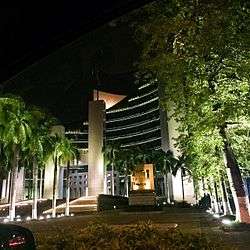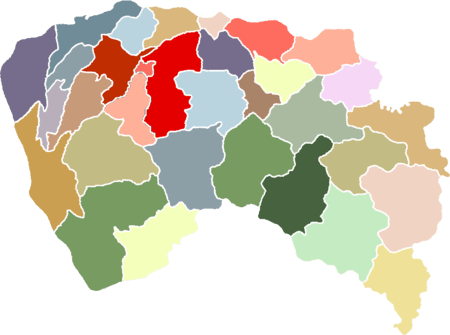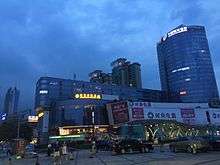Dongcheng Subdistrict, Dongguan
Dongcheng Subdistrict (simplified Chinese: 东城街道; traditional Chinese: 東城街道; pinyin: Dongchéng Jiēdào) is one of the four main subdistricts of Dongguan, Guangdong Province, China. It is under the administration of Dongguan city. It has an area of 110 square kilometres and a residential population of 500,000, of whom 300,000 are new residents.[1] The GDP of Dongcheng Subdistrict in 2015 reached 627.50 billion, an increase of 8% from the previous year.[2]
Dongcheng 东城街道 | |
|---|---|
Subdistrict | |
 The government building in Dongcheng Subdistrict | |
| Country | People's Republic of China |
| Province | Guangdong |
| Prefecture-level city | Dongguan |
| Area | |
| • Total | 110 km2 (40 sq mi) |
| Population | 500,000 |
| GDP | |
| • Total | ¥ 627.5 billion (2015 Data) |
| Time zone | UTC+8 (China Standard) |
| Website | dongcheng |
Basic information
| Chinese name | 东城街道 |
| Type of administrative division | Subdistrict |
| City | Dongguan |
| Subdivisions | Gangbei, Huayuan xincun, Dongtai, Wentang Community etc. |
| Address of government | No. 561, Dongcheng Street, Dongcheng Subdistrict, Dongguan |
| Area code | 0769 |
| Postal code | 523008-523129 |
| Location | Central northwest of Dongguan |
| Area | 110 km2 (42 sq mi) |
| Population | 500,000 |
| Dialect | Cantonese-Guancheng dialect |
| Climate | Humid subtropical climate (Cwa) |
Location
Map location of Dongcheng in Dongguan City


History
Dongcheng Subdistrict was originally named Fucheng District.
- In 1986, Dongguan dismantled the districts to establish the towns which have the jurisdiction over the villages.
- On 4 February 1986, the government of Guangdong Province approved Dongguan to disestablish the Guancheng Town (莞城镇), Huangcun District (篁村区), Wanjiang District (万江区) and Fucheng District (附城区), and established the Guancheng Subdistrict (莞城街道办事处), Wanjiang Subdistrict (万江区街道办事处), Fucheng Subdistrict (附城区街道办事处) and Huangcun Subdistirct (篁村区街道办事处).
- In March 2000, Dongguan dismantled the Fucheng Subdistrict to establish the Dongcheng Subdistrict.
Transport
.jpg)
There are four main highways in Dongcheng Subdistrict. Two expressways, the Dongguan-Shenzhen Expressway and the Guangzhou-Shenzhen Expressway, go through the Dongcheng Subdistrict. The public transport is convenient, 16 buses go through the center of the Dongcheng Subdistrict.
Among the four metro lines (R1-R4) planned for the Dongguan Rail Transit, R2 Line opened in May 2016, connecting Humen Railway station to Dongguan Railway Station (Shilong). The R2 Line passes through the Dongcheng Subdistrict at 4 stations — Liuhua Park station, the Xiaqiao station, the Dongcheng station, and the Qifeng Park station. The R2 Line also will link towns in Western Dongguan, thereby promoting the connection of the entire downtown area with Houjie, Humen and Chang’an. It will also support Dongcheng's regional transportation with other cities such as Guangzhou, Shenzhen, Hong Kong by joining with the rail transit junctions of the Pearl River Delta.[3]
English |
Hanzi |
|||
| Qifeng Park | 旗峰公园 | Dongcheng | ||
| Dongcheng | 东城 | |||
| Tianbao | 天宝 | Guancheng | ||
| Xiaqiao | 下桥 | Dongcheng | ||
| Liuhua Park | 榴花公园 | |||
Tourist attractions
Qifeng City Park
Qifeng City Park (旗峰公园) is one of the most famous and popular parks in Dongguan. It has an area of 2.34 square kilometers, and is located in the center of Dongcheng Substrict. There are some well-known tourist attractions in Qifeng City Park, like the Huangqi Mountain, the Huangqi Guanyin Temple and the Lantern of the Mountain (one of the eight famous Dongguan scenery). People climb the Qifeng Mountain on weekends and some important festivals.
The Huangqi Mountain (黄旗山) is a symbol of Dongguan. Its peak is 189 meters above sea level. The Huangqi Guanyin Temple, which was built in the Song dynasty and located at the foot of the hill, is a well-known temple in Dongguan. On the first day of the Chinese lunar New Year, Dongguan people go there to pray for the luck and wealth for the next year. Also, there is a tradition that people climb the Huangqi Mountain in the lunar New Year. Therefore, during the Spring Festival, the roads near the Huangqi Mountain are jammed with slow moving traffic because many people go there.
The R2 Subway Line passes through the Huangqi Mountain. People can get off at the Qifeng Park Station and it only a takes 2-minute walk from the subway station to the gates of the Qifeng Park.
Huying Park
Dongguan Huying Park (虎英公园) was built on the basis of the former Huying Forest Farm, covering an area of 2979 mu, and opened at the end of 2000. Huying country Park, with mountains and water, beautiful environment, lush forest, fresh air, lake and mountains, beautiful. It has built Tiger Pavilion, Qingyou Gorge, Lake Island, Yunyu Bridge, Roman Pillar Forest, Lake Ring Road, Barbecue, Sculpture Park military area, Scientist area, Ancient Beauty area and other scenic spots. The greatest feature is that there are a variety of figures and animal sculptures all over the garden, with famous figures and various animals from all over the world. The statue is lifelike and deity, giving people a good artistic enjoyment in sightseeing and leisure.
At the same time, Huying Park and Qifeng Park are connected by green lanes, and citizens can play inside the two parks by walking or cycling.
Liuhua Park

The Liuhua Park (榴花公园) was first built in the Ming dynasty, and it reopened in 1999. It has an area of 0.32 square kilometers, and is near the intersection of the Guanlong Road and the Guanjie Road. The park is open all day and has free admission. It is a key unit of Dongguan's cultural relics protection.
The most important tourist attraction in the Liuhua Park is the Liuhua Pagoda. It was built in the Ming dynasty. The first struggle in the Anti-Japanese War in Dongguan happened near the Liuhua Pagoda.[4] Others tourist attractions like Honghua Temple, Huaxi Yintang, and Qiniang Lake are also famous and attractive.
Dongcheng Culture Square
The Dongcheng Culture Square (东城文化广场), which is a well-designed and multi-functional entertainment venue, is located on the Dongcheng Road and has an area of 40,000 square meters, including a theatre, a gym, a library and an open-air music fountain. The theatre is large and is one of the best in the city, with about 1300 seats.
Infrastructure
CBD

Dongcheng Substrict has some well-developed business centers, with multi-functional office buildings, convenient shopping malls and residential areas.
- Dongcheng Wanda Square (Chinese: 东城万达广场[5])
- Dongcheng Shibo Square (Chinese: 东城世博广场)
- Xinghe City (Chinese: 星河城)
- Junhao Business Center (Chinese: 君豪商业中心)
- Yujing New Time Square (Chinese: 愉景新时代广场)
Medical and health
There are 655 medical institutions in Dongcheng Substrict. Here are some important hospitals in this area.
- Donghua Hospital attached to Sun Yat-sen University (Chinese: 中山大学附属东华医院)
- Dongcheng People's Hospital (Chinese: 东城人民医院)
- Dongguan No. 6 People's Hospital (Chinese: 东莞市第六人民医院)
- Dongguan Taixin Hospital (Chinese: 东莞台心医院)
Education
Here are some famous schools in Dongcheng Substrict:
- Dongcheng Junior Middle School (Chinese: 东城初级中学)
- Doncgcheng No. 1 Middle School (Chinese: 东城第一中学)
- Dongcheng Lingnan School (Chinese: 东城岭南学校)
- Dongcheng Primary School (Chinese: 东城小学)
- Dongcheng No. 5 Primary School (Chinese: 东城第五小学)
- Primary School attached to Dongguan Normal University (Chinese: 东莞师范附属小学)
- Dongguan Chaotian Experimental Primary School (Chinese: 东莞朝天实验小学)
References
- 东城街道概况. Dongcheng Subdistrict, Dongguan Government. Retrieved 25 October 2016.
- 2015年东莞市国民经济和社会发展统计公报. Dongcheng Subdistrict, Dongguan Government. Retrieved 22 November 2016.
- "Dongguan Railway Line R2 to begin trial operations in 2015". Dongguan Today. 31 May 2012. Retrieved 29 November 2016.
- Liuhua Park 榴花公园. Accessed 06 Dec. 2016
- 东城万达广场